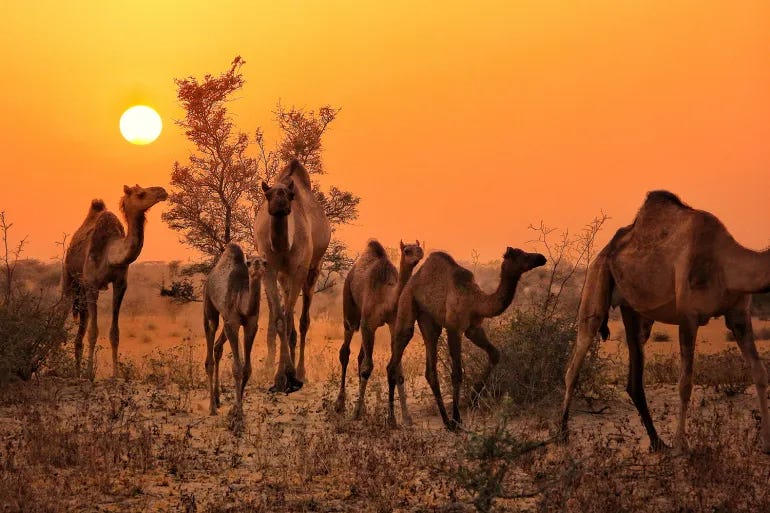India’s Declining Camel Population: A Law Meant to Protect Is Driving Them Toward Extinction
While the global camel population grows, India’s camels are disappearing at an alarming rate. Breeders and experts blame a 2015 law passed in Rajasthan as a key factor.
Rajasthan, India – In the arid desert landscape of Rajasthan, Jeetu Singh’s camels continue to graze, but there is a sense of sadness in the air. Singh, a 65-year-old camel breeder in Jaisalmer, watches as his herd of camels, once numbering over 200, has dwindled to just 25. The decline is painful for him, as the tradition of rearing camels once filled his youth with pride and competition among peers.
"When I was young, raising camels was a matter of pride," Singh recalls. "I used to decorate them, take care of them, and watch them roam in the desert. Now, it’s just a memory. I keep them out of attachment, not for profit."
While the camel population worldwide has grown from nearly 13 million in the 1960s to over 35 million today, the numbers in India are plummeting. The Food and Agriculture Organization (FAO) recently declared 2024 as the International Year of Camelids, recognizing the vital role camels play in many communities around the world. Yet in India, the camel population has dropped drastically from nearly one million in 1961 to approximately 200,000 today, with Rajasthan, the primary camel-breeding state, experiencing a significant decline in recent years.
In 2007, a livestock census showed Rajasthan’s camel population at around 420,000, but by 2019, that number had fallen to just over 210,000—a 35 percent drop in just seven years. In villages across Rajasthan, the situation is even more dire. In Anji Ki Dhani, for instance, camel numbers have fallen from 7,000 to a mere 200.
"We lost nearly 150 camels since the early 2000s," says Bhanwarlal Chaudhary, a camel breeder in Dandi village, as he walks with his herd of 30. "Camels are part of our culture, our survival. Without them, our way of life is meaningless."
The root of the problem, according to many camel breeders and experts, lies in the 2015 Rajasthan Camel (Prohibition of Slaughter and Regulation of Temporary Migration or Export) Act, which was enacted by the Bharatiya Janata Party (BJP)-led government. The law prohibits the transport, illegal possession, and slaughter of camels, and imposes harsh penalties, including prison terms and fines. However, it has unintentionally devastated the camel breeding industry.
Camel breeders say the law has led to the outlawing of camel markets, and buyers have become fearful of purchasing camels due to the legal ramifications. The traditional camel fairs, such as those in Pushkar, once thriving markets for camels, have seen the prices of camels plummet from 40,000 rupees ($466) to as low as 500 rupees ($6) post-law. Breeders have been left with no financial incentive to continue raising camels, and the lack of a market has led to further neglect of the animals.
Experts also argue that the law was based on a misconception that camel slaughter was the main cause of the decline in their population. While the law aimed to protect the camels, it inadvertently worsened their situation by eliminating key markets and reducing the incentives for breeders to care for them.
Ecologist Sumit Dookia questions the efficacy of the law, asking, "If the law is working to protect the camels, why is their population still declining?"
For many breeders, the law’s consequences go beyond economics. "The law has taken away our markets, our way of life," says Hanuwant Singh Sadri, a camel conservationist. "Before, the camels were a source of pride and sustenance, but now, they’re just another burden with no value."
Amid the ongoing political climate in India, where anti-Muslim sentiment has risen under the BJP’s rule, the law has also had a cultural impact. Many of the buyers at camel fairs were Muslim, and some breeders believe that the law, along with growing political tensions, has contributed to the fears surrounding the camel trade.
As the sun sets over Rajasthan, Jeetu Singh reflects on the future of his beloved camels. "Will the newborn camel bring good fortune to Rajasthan?" he wonders aloud. However, both Singh and Sadri are pessimistic about the outlook.
"The law has taken away our markets and will eventually take our camels," Sadri warns. "I won’t be surprised if there are no camels left in India in the next five to ten years. They will disappear like dinosaurs."
Former government official Narendra Mohan Singh, who was involved in drafting the law, admits that the legislation had unintended consequences. "We were given very little time to prepare the law, and breeders were not consulted," he says. "What was intended to protect camels has ended up harming them."
As debates continue over the law’s impact, the future of Rajasthan’s camels remains uncertain, with some fearing the animals will become nothing more than a distant memory. "If they aren’t extinct, they will eventually become a zoo attraction," Singh concludes with a grim outlook.


